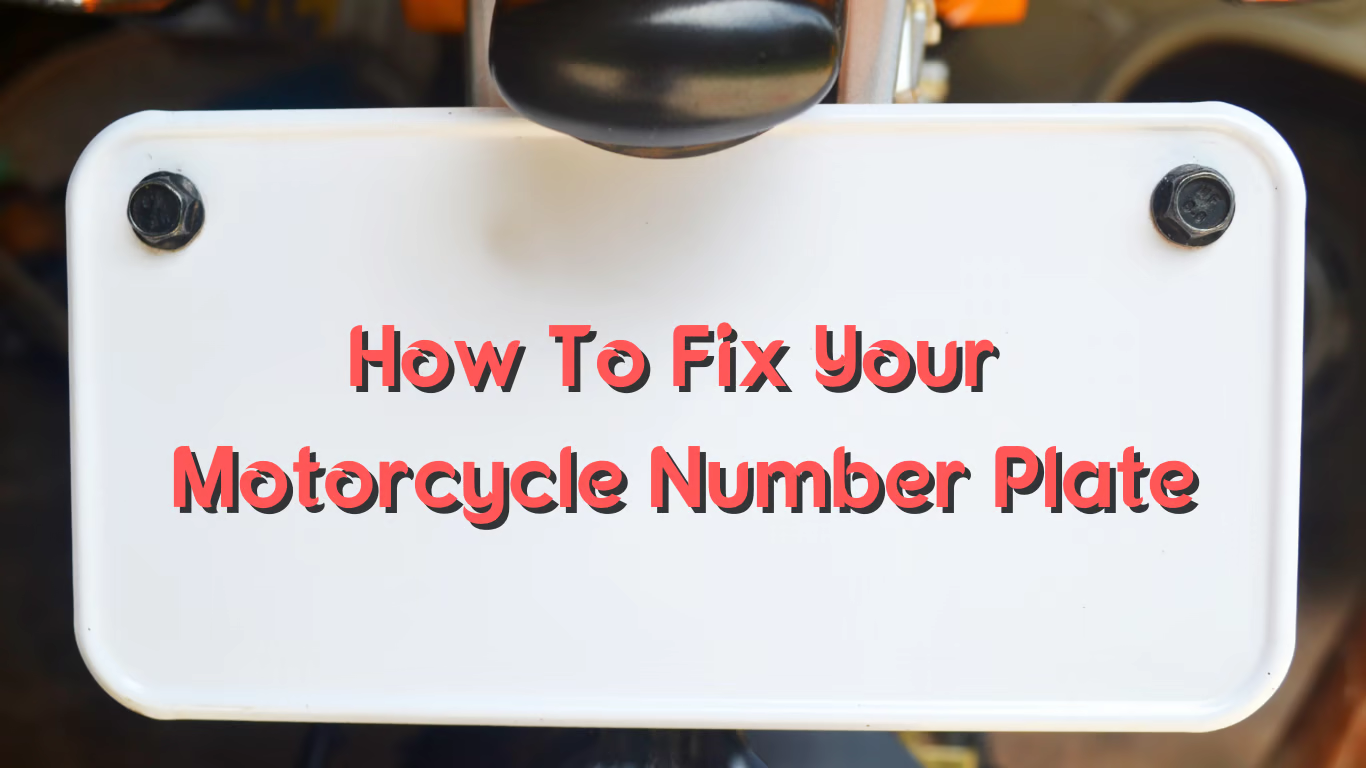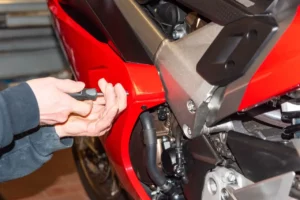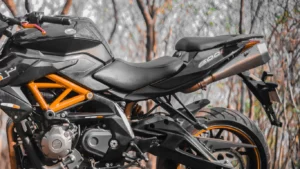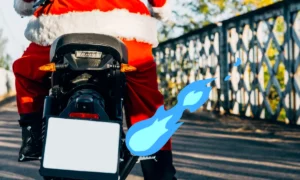Is your motorcycle’s number plate not looking its best? Perhaps it’s loosely attached, broken, or the digits are no longer clearly visible. Well, don’t worry. You’ve come to the right place to find a simple, easy-to-follow guide on how to fix your motorcycle number plate. Don’t let something so trivial add to the list of challenges on your adventurous ride.
Fixing a number plate can seem like a daunting task if you’ve never done it before, but rest assured, it’s easier than you might think. Whether it’s a matter of tightening loose screws, replacing a broken plate, or boosting the visibility of your plate’s digits, this handy guide will walk you through every step of the process. So, don your trusty work gloves, grab your toolbox, and let’s get your motorcycle’s number plate looking fresh and neat as new!
Why Fixing Your Motorcycle Number Plate is Important
Maintaining the correct display of your motorcycle license number is no trivial matter. It’s not just about avoiding potential fines or legal consequences. Ensuring that your number plate is in good condition and is clearly visible is also crucial for safety and identification purposes. From tracking a stolen vehicle to permitting easy identification in case of an accident, the benefits are innumerable.
The Role of a Number Plate
You might not give it much thought, but your motorcycle’s license plate fulfills some significant duties. It’s not just a unique identifier for your vehicle- it’s a vital piece of information that helps law enforcement and other agencies trace your bike. It’s also indispensable in instances of theft or loss, where a clearly visible and well-maintained license plate can expedite recovery.
Compliance with the Law
Depending on your location, there could be specific regulations concerning the maintenance and display of motorcycle license plates. Complying with these laws is crucial, and failure to do so can result in hefty penalties or even issues with your insurance coverage. So, to stay on the right side of the law, it’s essential to keep your motorcycle license plate in top condition.
Promoting Safety
A neatly fixed license number promotes road safety. It enables other road users and pedestrians to easily identify your motorcycle. This importance becomes particularly pronounced in times of emergencies or accidents, where quick identification can prove vital.
Also Read:
- 7 Reasons Why My Motorcycle Battery is Sparking When I Hook It Up?
- 5 Major Reasons Why Is Your Motorcycle Running Rich?
Choosing the Right Tools and Materials
When it comes to fixing your motorcycle license plate, having the appropriate tools and materials at hand is half the battle. Accurate selection of these resources is crucial for the task to be efficiently completed. Don’t worry if you’re a first-timer; with the right guidance and patience, you’ll be able to do it perfectly!
Essential Tools and Materials
Your toolbox for this project should include a number plate, a screwdriver set – preferably one that caters to both flat head and Philips head screws, durable bolts and screws, and a drill with various bit sizes.
Obtaining a New Number Plate
If the existing license plate is damaged beyond repair, you’d have to obtain a new one. In the U.S., every state’s Department of Motor Vehicles can help you replace your license plate. Just remember to carry all necessary identification and vehicle information with you.
Picking the Right Screwdriver
Although a screwdriver seems a basic tool, its importance cannot be overstressed. Different motorcycles use different types of screws, hence a set is recommended. For plastic number plates, those being the most common, decide towards a Philips head.
Proper Bolts and Screws
The right bolts and screws ensure your license plate stays firmly in place. It’s advisable to opt for rust-resistant types, so your license plate remains attached even under harsh weather conditions.
Having a Drill Handy
You might need to drill new holes for the screws in your number plate or motorcycle. Be sure the drill you use has adjustable bit sizes to align correctly with the bolt size.
Step-by-Step Guide to Removing the Old Number Plate
Embarking on the task of fixing your motorcycle’s license plate may seem daunting, but with the right tools and a little patience, it’s a surprisingly straightforward task. The first step in this process is removing the old license plate. The removing process might feel complex if you’re a beginner, but don’t worry, we’ll walk you through each step to ensure you can get it done with ease.
Begin with Safety Precautions
A good place to start is by taking care of your safety. Ensure you’re wearing a pair of sturdy gloves to protect your hands from any potential sharp edges on the plate or mounting hardware.
Examine and Understand the Mounting Mechanism
Motorcycle license numbers are typically mounted onto the bike using screws or bolts. Take a moment to understand how your specific license number has been attached. This insight will determine the type of tools you require for the task.
Loosening the Bolts or Screws
Once you have your right-sized screwdriver or wrench, apply some elbow grease and proceed to loosen the screws or bolts. It’s important to use deliberate, steady pressure to avoid stripping the heads of the bolts or screws.
Remove the Old Number Plate
With the screws or bolts sufficiently loosened, you can now remove the old license number. Handle it gently to avoid causing any unnecessary damage that might harm you or your motorcycle.
Prepare for The New Number Plate
Finally, make sure the area where the plate was attached is clean and ready for a new license plate. A quick wipe down with a soft, clean cloth can usually do the trick. Remember, a well-prepared area will result in a smoother installation of the new license number.
Examining and Repairing Damaged Number Plate Mounts
After successfully removing your old motorcycle license plate, the next step is to thoroughly examine and potentially repair any damage to the license plate mounts. This step is crucial to ensuring the secure and correct positioning of your new license number, therefore keep your eyes peeled for any rust, cracks, or breaks in the mounting brackets or screws.
Inspect the Mounting Brackets
Begin by closely inspecting the mounting brackets. They are responsible for holding the license number in place, so it’s essential to check that they are intact and free of any serious damage. If you notice any cracks, rust, or other signs of wear and tear, consider replacing them to achieve a more secure hold.
Check the Screw Holes
Next, take a close look at the screw holes. Over time, these can become enlarged or misshapen due to strain from the plate and any impacts your bike may have experienced. If the screw holes are damaged, they may not tightly secure the screws, causing the plate to wobble or even fall off while riding. As a solution, you can realign the holes using a small file or replace the bracket if necessary.
Examine the Screws and Bolts
Finally, examine the condition of the screws and bolts that hold the plate in place. If they’re rusted or stripped, they may not provide a secure grip. In such cases, it’s best to replace them with new ones of the same size. This will ensure your plate is held tightly and expectedly, minimizing the risk of any unexpected incidents. Ensure to have properly sized screws and bolts at your disposal.
Replacing Missing or Broken Number Plate Screws
Replacing missing or damaged screws on your motorcycle license plate is a task you don’t need a professional to handle. With the right tools, you can quickly fix them and save a trip to the auto shop. Plus, it paves the way for a smoother license number replacement or repair process, should you need one in the future.
Detecting the Issue
Firstly, closely inspecting the number plate region to find out whether if there’s any screw missing or damaged is crucial. Regular check-ups can help detect issues earlier before escalating into a bigger problem.
Tool Selection
Having the correct-sized screwdriver is key when replacing screws on your number plate. An incorrect tool can end up damaging the screw head, putting you in an even more challenging situation. Also, a wrench could be helpful if the screws have become particularly rusted or tough to handle.
Choosing the Suitable Screw
There’s a plethora of screw options available in the market. However, you want to pick screws that are appropriate for your motorcycle and number plate. Stainless steel screws are recommended, as they are resistant to rust and can withstand varying weather conditions effectively.
Installation Process
The installation process for replacing screws is quite straightforward. Simply take out the damaged or missing screw, then place and tighten the new one. Ensure you don’t overturn and damage the screw or the number plate. Repeat as necessary, until all screws are replaced.
Regular Maintenance
Like other parts of your motorcycle, the license number and its hardware need regular maintenance. Checking them periodically for missing or damaged screws is an effective preventative measure. This proactive approach can save you time and effort in the long run.
Preparing the New Number Plate for Installation
After setting things straight with your old number plate, and making sure that everything else is ready, it’s time to prepare your new number plate for installation. Success lies in proper preparation, so you’ll want to ensure you’ve set everything up right to allow for a seamless process.
Inspect the New Number Plate
Begin by giving your new number plate a thorough scan for any defects or abnormalities. Check for any scratches or dents before installing, as you don’t want to be installing a damaged plate.
Measure and Mark for the Holes
Use the old number plate as a guide to determine where to position the holes on your new plate. Measure carefully and then mark the spots for the screw holes. Remember, precision here is key for a flawless fit.
Drill Holes in the New Number Plate
Once you’ve marked the spots, it’s time to drill the holes. Make sure the size of the holes is appropriate for the screws you’ll be using. Be careful not to apply too much pressure to avoid cracking, or worse, breaking the plate.
Double Check Everything
Last, but definitely not least, double-check all your measurements and the hole positions. It’s crucial to ensure your number plate aligns properly with the mounting bracket on the motorcycle. If everything checks out, you are ready to proceed to the installation process!
Aligning and Attaching the New Number Plate
You’ve prepared your new number plate and the motorcycle for installation, it’s now time to put everything together. This final process involves aligning and attaching your new motorcycle number plate to ensure its visibility and security. Your role here is to ensure the plate is properly affixed without causing any damage to it or the mounting bracket. Additionally, the alignment should be correct to prevent any further issues.
Aligning the New Number Plate
Start by aligning the holes on your new number plate with the screw holes on the mounting bracket of your motorcycle. For this task, it might be helpful to use a spirit level to ensure that the plate is horizontally stable. Incorrect alignment can lead to the plate appearing tilted or skewed, which can attract fines or penalties if not rectified promptly.
Attaching the New Number Plate
With your number plate optimally aligned, you’re ready to attach it. Slot the screws through the holes on the plate and into those on the bracket. Using your chosen screwdriver, gently tighten the screws, ensuring the number plate is secure but without applying too much pressure that could damage the plate or the screw threads.
Double-checking the Installation
Lastly, give your installation a thorough check. Make sure the number plate is firmly attached and sits level with your motorcycle. The screws should be tight enough, but not overly so. Remember, the plate should be clearly visible from a distance and properly illuminated. Checking these details now will save you headaches and potential fines down the road.
Sealing and Protection
To protect your efforts, consider using a sealant around the screws heads to keep them from loosening due to vibrations while on the move. Also, use clear and non-reflective protective covers that conform to legal requirements. This aids in prolonging the life of your number plate and maintaining its legibility and cleanliness.
Ensuring Proper Visibility and Angle of the Number Plate
Once you’ve completed the installation of your new motorcycle number plate, the final thing to consider is its placement. It’s critical to ensure that your number plate is both visible and properly angled. This is not just a requirement for legal compliance, but also a safety measure. Other motorists and authorities must be able to identify your motorcycle at all times, particularly in instances of accidents or traffic violations, and poor placement or angle can hamper this.
Checking Visibility
After attaching your new number plate, step back from your motorcycle and scrutinize it from different angles. Make sure the characters on the plate are readable from a reasonable distance. If not, adjusting the angle or positioning may be required.
Verifying the Angle
The angle of your license plate can greatly impact its readability. Ideally, it should be mounted horizontally, parallel to the ground. An excessively tilted plate can be difficult to read or interpret from a distance, and can also lead to glare issues in certain lighting conditions.
Testing at Different Lighting Conditions
Remember to check visibility during different times of the day and under varying lighting conditions. Your number plate should be readable under direct sunlight, at dusk, and at night, under artificial lighting. Any issues might warrant the use of reflective plates or additional lighting.
Meeting State/Local Regulations
Each state or locality may have specific regulations concerning number plate visibility and placement. Be sure to familiarize yourself with these rules to avoid any penalties or violations. Some areas may even require a plate light to ensure visibility at night.
Tips for Securing the Number Plate for Longevity
Maintaining the longevity of your motorcycle number plate is just as important as the installation process itself. Proper care and attention can prevent the need for continuous replacements, saving you time and money in the long run. Below are a few useful tips to keep in mind in order to promote number plate longevity.
Regular Cleaning
One of the ways to ensure the longevity of your number plate is by keeping it clean. Over time, dirt, dust, and debris can adhere to the plate, affecting its visibility. Cleaning it regularly with a mild soap solution and a soft cloth can help to maintain its clarity, thus promoting duration.
Avoid Chemical Cleaners
While keeping your number plate clean is essential, it’s important to avoid the use of harsh chemical cleaners. These agents may cause the color of the lettering to fade, and could even result in the plate cracking or peeling, further reducing its lifespan.
Check Tightness of Screws
The screws securing your number plate should be checked frequently to make sure they are tight and not at risk of falling out. A loose screw can cause the number plate to wobble or, worse, come off entirely during your ride.
Use Suitable Screw Covers
Using suitable screw covers can help protect the screws from rusting or corroding due to exposure to the elements. This will enhance not only the lifespan of the screws but also that of the number plate.
Apply a Protective Coating
Applying a protective coating to your number plate can help guard against damage from weathering and the elements. Just ensure the product you choose doesn’t obscure the plate’s visibility, as this could result in a fine or penalty.
Adding Personalization to Your Motorcycle Number Plate
Personalizing your motorcycle number plate isn’t just legally acceptable, it’s also a great way to make your motorcycle stand out and reflect your personality. While the options depend on your state’s motor vehicle department regulations, some common ways to personalize include unique icons, letters, numbers or a combination of all. These can truly make the plate a one-of-a-kind signature of your ride.
Choosing a Unique Identifier
The simplest and most common way to personalize your number plate is to choose your own unique identifier – a combination of letters and numbers that mean something to you. This could be your initials, a nickname, or a meaningful number. Always check the availability with your local transport authority.
Adding a Personal Touch with Icons
Depending on the rules in your area, you might be able to add a small icon—like a heart, star, or fist—to your number plate. This can add a personal touch and help your motorcycle stand out from the rest.
Creating a Unique Design
Another way to personalize your motorcycle number plate is by incorporating unique designs. Some services offer border design options or even the opportunity to upload your own design. Although these modifications must still be easily readable and compliant with local regulations.
Keeping Legality in Mind
Last but not least, it is crucial to ensure that your personalization is still legal. It’s important to check with your local motor vehicle department to understand the regulations for personalization, and keep in mind that illegal plates can result in fines or penalties.
Frequently Asked Questions about Motorcycle Number Plate Fixing
Why should I fix my motorcycle number plate?
Fixing your motorcycle number plate is essential to ensure compliance with the law, safety and proper identification of your motorcycle. Besides, a well-fixed plate can help add to the aesthetic appeal of your machine.
What tools do I need to fix my motorcycle number plate?
You would require a number of tools and materials, including a new number plate if needed, a screwdriver that fits the plate’s screws, proper bolts and screws for it, and potentially a drill if you need to create new holes.
How do I remove the old motorcycle number plate?
Be sure to consider safety first. Examine and understand how the old plate is mounted, then gently loosen the bolts or screws. You can then remove the old plate and clean up in readiness for the new number plate.
What should I check when repairing the motorcycle number plate mount?
Inspect the condition of the mounting brackets and the screw holes. Examine the state of existing screws and bolts and replace them if they are worn out or broken.
How should I prepare the new motorcycle number plate for installation?
First, inspect the condition of the new license number. Then, measure the distance between the mounting holes and mark these on your new number plate. Drill the holes as marked, and finally, double-check everything to ensure accuracy.






